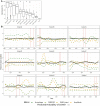Evaluation of a machine learning approach utilizing wearable data for prediction of SARS-CoV-2 infection in healthcare workers
- PMID: 35677186
- PMCID: PMC9129173
- DOI: 10.1093/jamiaopen/ooac041
Evaluation of a machine learning approach utilizing wearable data for prediction of SARS-CoV-2 infection in healthcare workers
Abstract
Objective: To determine whether a machine learning model can detect SARS-CoV-2 infection from physiological metrics collected from wearable devices.
Materials and methods: Health care workers from 7 hospitals were enrolled and prospectively followed in a multicenter observational study. Subjects downloaded a custom smart phone app and wore Apple Watches for the duration of the study period. Daily surveys related to symptoms and the diagnosis of Coronavirus Disease 2019 were answered in the app.
Results: We enrolled 407 participants with 49 (12%) having a positive nasal SARS-CoV-2 polymerase chain reaction test during follow-up. We examined 5 machine-learning approaches and found that gradient-boosting machines (GBM) had the most favorable validation performance. Across all testing sets, our GBM model predicted SARS-CoV-2 infection with an average area under the receiver operating characteristic (auROC) = 86.4% (confidence interval [CI] 84-89%). The model was calibrated to value sensitivity over specificity, achieving an average sensitivity of 82% (CI ±∼4%) and specificity of 77% (CI ±∼1%). The most important predictors included parameters describing the circadian heart rate variability mean (MESOR) and peak-timing (acrophase), and age.
Discussion: We show that a tree-based ML algorithm applied to physiological metrics passively collected from a wearable device can identify and predict SARS-CoV-2 infection.
Conclusion: Applying machine learning models to the passively collected physiological metrics from wearable devices may improve SARS-CoV-2 screening methods and infection tracking.
Keywords: COVID-19; apple watch; coronavirus; machine learning; wearable device.
© The Author(s) 2022. Published by Oxford University Press on behalf of the American Medical Informatics Association.
Figures



References
-
- He X, Lau EHY, Wu P, et al. Temporal dynamics in viral shedding and transmissibility of COVID-19. Nat Med 2020; 26 (5): 672–5. - PubMed
-
- Hirten RP, Stanley S, Danieletto M, et al. Wearable devices are well accepted by patients in the study and management of inflammatory Bowel disease: a survey study. Dig Dis Sci 2020; 66 (6): 1836–44. - PubMed
Grants and funding
LinkOut - more resources
Full Text Sources
Miscellaneous
